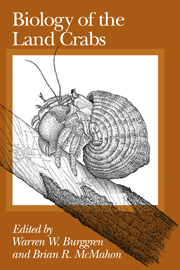Book contents
- Frontmatter
- Contents
- List of contributors
- Preface
- 1 BIOLOGY OF THE LAND CRABS: AN INTRODUCTION
- 2 EVOLUTION, SYSTEMATICS, AND GEOGRAPHICAL DISTRIBUTION
- 3 ECOLOGY
- 4 BEHAVIOR
- 5 REPRODUCTION AND DEVELOPMENT
- 6 GROWTH AND MOLTING
- 7 ION AND WATER BALANCE
- 8 RESPIRATION
- 9 CIRCULATION
- 10 ENERGETICS AND LOCOMOTION
- 11 EPILOGUE
- APPENDIX: Natural histories of selected terrestrial crabs
- References
- Author index
- Systematic index
- Subject index
5 - REPRODUCTION AND DEVELOPMENT
Published online by Cambridge University Press: 04 August 2010
- Frontmatter
- Contents
- List of contributors
- Preface
- 1 BIOLOGY OF THE LAND CRABS: AN INTRODUCTION
- 2 EVOLUTION, SYSTEMATICS, AND GEOGRAPHICAL DISTRIBUTION
- 3 ECOLOGY
- 4 BEHAVIOR
- 5 REPRODUCTION AND DEVELOPMENT
- 6 GROWTH AND MOLTING
- 7 ION AND WATER BALANCE
- 8 RESPIRATION
- 9 CIRCULATION
- 10 ENERGETICS AND LOCOMOTION
- 11 EPILOGUE
- APPENDIX: Natural histories of selected terrestrial crabs
- References
- Author index
- Systematic index
- Subject index
Summary
Introduction
Anomuran and brachyuran crabs show varying degrees of terrestrial adaptation, ranging from species that venture out of water only briefly to those that actually inhabit arid or semiarid lands and depend on bodies of water for reproductive purposes only. Among the Anomura, considerable terrestrial adaptation is seen in the family Coenobitidae (land hermit crabs). Adults of the genus Coenobita are permanently confined to molluscan shells in which provision is made to trap water, whereas Birgus exhibits the shell-dwelling habit only during the early part of its life. The coconut crab Birgus latro returns to the ocean only to release the brood. Among the Brachyura there is a wide range of variations in habitat. For example, the shore crab, Carcinus maenas, wades through shallow water and wanders over the beach, hiding in burrows made in wet sand. The Ocypodidae are amphibious crabs inhabiting littoral waters and estuaries. Among grapsids, some are inhabitants of rocky shore and some are terrestrial. Some frequent mangroves and yet others live in fresh water. The Gecarcinidae are best adapted for terrestrial life, but they turn to the sea to breed. The freshwater crabs Parathelphusa hydrodromus and Gecarcinucus steniops depend on fresh water of the rice fields primarily for brood release and for the development of the young. Not surprisingly, the tremendous diversity observed in habitats of crabs is reflected in their re-productive and developmental biology.
Breeding seasons of land crabs
The breeding cycles of crabs are programmed to a great extent in accordance with cues received from diverse environmental factors, such as availability of food and water, temperature, salinity, lunar phases, tidal cycles, and competition between congeneric species (also see Chapter 3).
- Type
- Chapter
- Information
- Biology of the Land Crabs , pp. 139 - 185Publisher: Cambridge University PressPrint publication year: 1988
- 26
- Cited by



